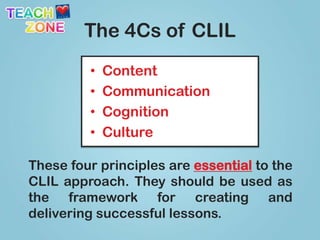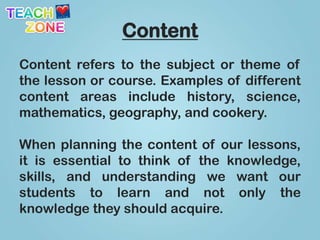The 4Cs Of CLIL - Module 1
- 1. CLIL ATTACK! The 4Cs of CLIL 1st Module
- 2. The 4Cs of CLIL ŌĆó Content ŌĆó Communication ŌĆó Cognition ŌĆó Culture These four principles are essential to the CLIL approach. They should be used as the framework for creating and delivering successful lessons.
- 3. Content
- 4. Content Content refers to the subject or theme of the lesson or course. Examples of different content areas include history, science, mathematics, geography, and cookery. When planning the content of our lessons, it is essential to think of the knowledge, skills, and understanding we want our students to learn and not only the knowledge they should acquire.
- 5. Communication BecauseŌĆ” I thinkŌĆ” In my opinionŌĆ” Here it saysŌĆ”
- 6. Communication Communication refers to students using the target language to communicate their thoughts, opinions, attitudes, and discoveries related to the lesson content. Both speaking and writing are emphasized as students ŌĆ£learn to use language and use language to learnŌĆØ. (Coyle) ŌĆó Students engage in meaningful interaction with each other. Group work is very common. ŌĆó The aim is for students to produce authentic language, not to memorize grammar rules and parrot the teacher. ŌĆó The teacher serves as guide/facilitator.
- 7. Cognition
- 8. Cognition Cognition refers to the critical thinking skills that students use to engage with and understand course content, to solve problems, and to reflect on their learning. ŌĆó A taxonomy such as the one designed by Anderson and Krathwohl (2001) is a helpful guide as we plan lessons. Click the link below for further information (in italiano).
- 9. Culture
- 10. Culture Culture (also known as community and citizenship) refers to the learning community of a class and school and more broadly to local and global cultures. Students are encouraged to understand themselves as citizens of the world and understand both their own culture and other cultures. The ultimate goal is to promote international awareness and understanding.
- 11. Bibliography Adapted from: ŌĆó Mehisto, Peeter, David Marsh, and Maria Jesus Frigols. Uncovering CLIL. Macmillan Education, 2008. ŌĆó Coyle, Do, Philip Hood, and David Marsh. CLIL. Cambridge University Press, 2010.










